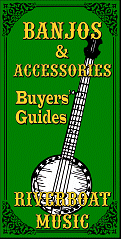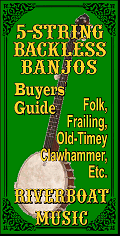Acoustic Instrument
Primers
What Kind of Guitar
Should I Start On?
What Kind of Banjo
Do I Want?
Evaluating and
Buying Used
Guitars
Setting Up
Fretted Instruments Whatever Happened
to the Banjo?
Beginning Five-
String Folk Banjo
6-String Banjos
Banjo Pickups
Axes in my Life
What is a
Bluegrass Banjo?
Dean "Backwoods
Six" Shootout
What is a Zither Banjo?
Music Theory
Primers
Introduction
to Scales
Introduction
to Chords
Circle of Fifths
Other Articles
About Music
How to Give
Guitar Lessons
Musician or
Wannabe? Did God Really
Give Rock &
Roll to You?
Are You a
"Brand Bigot"?
Who Owns Folk Songs?
Historical Links
About the
National Road
The Story Behind
the Story - Real
People, Places,
and Events
About the Play
Play Home
What's New
Overview
About the
Music
About the
History
About the
Logistics
About the
Cast
Synopsis
About the
Set
About the
Author
Contact Us
Home

Lesson 1b: Tuning Your Banjo
| Edited by Paul Race for Creek Don't Rise? |
|
Editor's Note: Between 1999 and 2004, Mitchel "Mickey" Cochran posted an extensive collection of free musical instrument lessons on his FolkOfTheWood.com web page. Sadly, we lost Mickey in 2011. After e-mailing surviving family members for permission to repost some of Mickey's most popular materials, we have begun restoring them to host on these pages. (Please see the Introduction page for more information on that effort.) This page is Mickey's explanation of how to tune the 5-string banjo. - Paul Race |
Lesson 1b: Tuning Your BanjoStandard G tuning for the banjo is: Here a Sound Sample of 5-String Open G Standard Tuning Here's a diagram illustrating this tuning sequence with each string's note denoted along with the corresponding tuners:
1. Electronic Tuner:
Consider buying an electronic tuner. This is by far the
easiest way to get tuned and started. You can visually determine whether
a string is out of tune by LCD readout or LED indicator...depending on
the type of tuner you purchase. You'll also spare your family's ears by
practicing in tune. Imagine how much more inspiring it is to learn to
play when you're optimally tuned. On a banjo, since it's tuned to an
open chord, you'll sound good from the start by utilizing an electronic
tuner.
Note from Paul: Since Mickey wrote this part, "clip-on" tuners have become the rage. The advantage of these is that you can leave them on and tune between songs during your sets. The disadvantage of these is that they all take a little battery the size of a dime that might be hard to find if you need to replace it in a hurry.
Unfortunately, guitar tuners will not help you much. The middle three of the banjo's strings are typically tuned like guitar strings, but you're on your own for the two on the outside. Chromatic tuners sense and automatically show tuning information for every note (including Ab, etc.) So they can be more complicated to gets used to. Once you get close to the tuning you need, they are VERY helpful. But if you can get someone to help you get close the first time, that will be very helpful.
Click here to see a range of handy clip-on tuners on Amazon. 2. Pitch Pipe: These
are fine, except when you're just starting out, you haven't had a
chance to develop your ear enough to differentiate whether a string is
sharp or flat from a reference note. 3. Guitar:
If you already play guitar, you can simply match the 2nd, 3rd and 4th
string to your banjo's 2nd, 3rd and 4th. From here, match your 1st
string to the banjo's 2nd string fretted at the 3rd. You may now tune
the 5th string by matching it to the 1st fretted at the 5th. 4. Tune it to itself:
If you've had no background in music this would be next to impossible,
and I'd highly recommend buying and electronic tuner. If you do have a
background in music, simply start by having a reference pitch. For
instance, if you have a reference for the D string (4th String) you're
ready to start. After tuning the D string, fret the D string and the 5th
fret to get a reference for your G string (3rd string). On the G
string, fret the 4th fret to get a reference for tuning the 2nd string.
From here, match your 1st string to the banjo's 2nd string fretted at
the 3rd. You may now tune the 5th string by matching it to the 1st
fretted at the 5th. Upon
tuning to any of the above methods, you may find that your banjo still
doesn't sound right. A couple of things to consider would be: 1. Bridge
Placement: if the bridge is not properly placed, the intonation will be
out and it will be impossible to tune. To correct this, place a ruler
from the nut to the 12th fret and measure it accurately. Now, using the
same measurement, place the bridge the exact same distance from the 12th
fret.
Note from Paul: Mickey knew there was more to it than this, but he didn't want to confuse people too much at first. Details on how to fine-tune bridge placement are provided in our article "Setting Up a Five-String Banjo." Scroll down to the heading "Fine-Tune the Bridge Placement".
2. Old Strings: if your strings are very old and rusty, you'll find it easier to tune once you've replaced them. |
Conclusion
Mickey's instructions are as valid today as when he wrote and recorded them years ago. Here's hoping that you find them just as helpful as his original followers did back when he was interacting on a daily basis with his them.
Please contact us if you're hitting any brick walls and we'll try to help you get therough them.
Best of luck, all, enjoy your music, and support the arts.
Paul Race
And when you're ready to move on, click here to go to the next part of this online lesson.

|

|


All text and any illustrations and/or videos within the white box above are copyright 1999-2004 by Mitchell Cochran. All other materials, illustrations, and content on this web page, including the text reformatting and illustration restoration within the white box are copyrighted ? 2016 by Paul D. Race. All rights reserved.
Creek Dont' Rise(tm) is a participant in the Amazon Services LLC Associates Program, an affiliate advertising
program designed to provide a means for sites to earn advertising fees by advertising and linking to Amazon.com.
For questions, comments, suggestions, trouble reports, etc. about this page or this site, please contact us.
| Visit related pages and affiliated sites: | |||||
| - Music - | |||||

|
 |
 |

|

|

|

|

|

|

|

|

|

|

|

|

|

|

|
| - Trains and Hobbies - | |||||
 |

|

|  |
 |

|
| - Christmas Memories and Collectibles - | |||||
 |

|
 |

|
 |

|
| - Family Activities and Crafts - | |||||
 |

|

|

|

|

|


